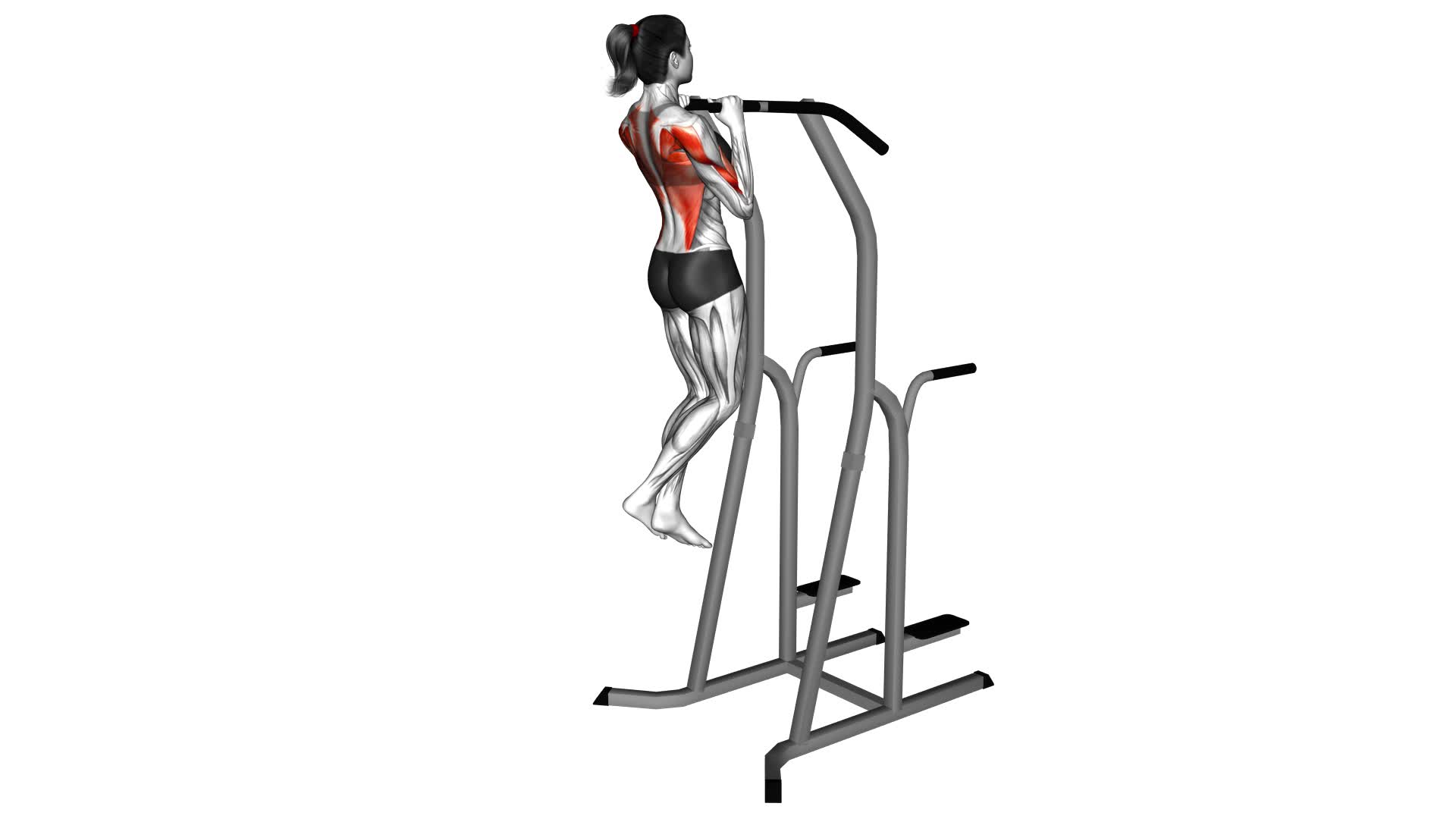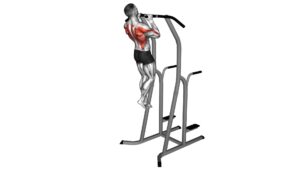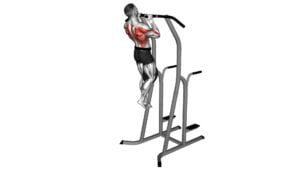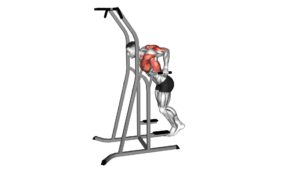Hammer-Grip Pull-up on Dip Cage (female) – Video Exercise Guide & Tips

In this video exercise guide, you'll learn how to perform the hammer-grip pull-up on a dip cage specifically designed for females.
Watch This Exercise Video
This exercise targets your upper body, helping you build strength and tone your muscles.
We'll show you the proper set-up and equipment needed, along with step-by-step execution instructions.
Avoid common mistakes, and get tips for progression and increasing difficulty.
Remember to prioritize safety and make necessary modifications.
Let's get started!
Key Takeaways
- Hammer-grip pull-ups on a dip cage target upper body muscles and provide a well-rounded upper body workout.
- Proper set-up and equipment, including a sturdy dip cage with adjustable height settings, are necessary for safe and effective execution.
- Maintaining a proper grip technique, with shoulder-width distance between hands and palms facing each other, is important for engaging the correct muscles.
- Gradually increasing weight or resistance, using equipment such as weight belts or resistance bands, and progressing to advanced variations can help challenge and improve strength and fitness level.
Benefits of Hammer-Grip Pull-up on Dip Cage
Boost your upper body strength with the Hammer-Grip Pull-up on Dip Cage. This exercise not only targets your back and arms but also works your grip strength, which has many benefits. Grip strength is essential in daily activities like carrying heavy objects and opening jars. By improving your grip strength, you can enhance your overall strength and functional fitness.
The Hammer-Grip Pull-up on Dip Cage is just one variation of pull up exercises that you can incorporate into your workout routine. Other variations include wide-grip pull-ups, chin-ups, and close-grip pull-ups. Each variation targets different muscles in your upper body, providing a well-rounded workout.
In addition to building upper body strength, the Hammer-Grip Pull-up on Dip Cage also helps to improve your posture and stability. When performing this exercise, you engage your core muscles to maintain proper form. This, in turn, strengthens your core and helps to support your spine, reducing the risk of back pain and injuries.
Now that you understand the benefits of the Hammer-Grip Pull-up on Dip Cage, let's move on to the next section, where we'll discuss the proper set-up and equipment needed for this exercise.
Proper Set-up and Equipment
To properly set up for hammer-grip pull-ups on a dip cage, you'll need the necessary equipment.
Make sure you have a dip cage with a sturdy frame and adjustable height settings.
Additionally, ensure that you have a secure and comfortable grip on the handles before starting the exercise.
Equipment for Pull-Ups
When setting up for pull-ups, make sure to use the proper equipment and set it up correctly. Here are some key points to consider when it comes to equipment for pull-ups:
- Different variations of pull-up equipment: There are various types of equipment available for pull-ups, including pull-up bars, dip cages, power towers, and doorframe pull-up bars. Each type offers its own unique features and benefits.
- Choosing the right equipment for your fitness level: It's essential to select equipment that matches your fitness level and goals. For beginners, a simple pull-up bar or doorframe pull-up bar may be sufficient. Intermediate or advanced individuals might opt for a dip cage or power tower that offers additional exercise options.
- Proper installation and stability: Ensure that the equipment is securely installed and stable before attempting any pull-up exercises. This will help prevent accidents or injuries during your workout.
Now that you understand the importance of using the correct equipment for pull-ups, let's move on to the next section, where we'll discuss setting up the dip cage.
Setting up Dip Cage
To properly set up the dip cage for your workout, start by positioning it in a sturdy and secure location. Make sure it's placed on a flat surface and check that all its parts are secure and stable.
Once the dip cage is set up, you can explore various dip cage variations and alternative grip techniques to add variety and challenge to your workouts. Some dip cage variations include using resistance bands or adding weight plates to increase the intensity of your dips.
When it comes to grip techniques, you can try the traditional overhand grip, underhand grip, or even the hammer grip for different muscle engagement. Experiment with different variations and grips to find what works best for you and your fitness goals.
Proper Grip Technique
Position yourself in front of the dip cage and grab onto the handles with a firm and secure hammer grip. This hand position will ensure proper muscle activation and help you perform the exercise effectively.
Here are some important tips to keep in mind regarding your grip technique:
- Maintain a shoulder-width distance between your hands on the handles.
- Wrap your fingers around the handles with your palms facing each other.
- Keep your wrists straight and avoid any excessive bending or twisting.
- Squeeze your grip tightly to engage your forearm muscles and maintain control throughout the movement.
By following these guidelines, you'll optimize your hand position, enhance muscle activation, and improve your performance during the hammer-grip pull-up on the dip cage.
Remember to focus on maintaining a strong grip throughout the exercise for maximum benefits.
Step-by-Step Execution
First, position yourself on the dip cage with a hammer grip. This grip involves placing your palms facing each other, with your thumbs wrapped around the bar. This is a great exercise for strengthening your back, shoulders, and arms.
To begin, hang from the dip cage with your arms extended. Engage your core and squeeze your glutes to maintain stability throughout the movement. Take a deep breath in, then exhale as you pull yourself up towards the bar. Focus on engaging your back muscles, squeezing your shoulder blades together, and pulling your elbows down towards your sides.
As you progress in your training, you can increase the difficulty of this exercise by adding weight or using resistance bands for assistance. Safety modifications can be made by using a spotter or wearing a weight belt for added support.
Now that you have a grasp of the step-by-step execution, let's move on to the next section where we'll discuss common mistakes to avoid. By understanding these mistakes, you can ensure that you're performing the hammer-grip pull-up correctly and effectively.
Common Mistakes to Avoid
To ensure a successful hammer-grip pull-up on the dip cage, it's important to avoid common mistakes.
One common mistake is incorrect hand placement, which can lead to discomfort or potential injury.
Another mistake to avoid is a lack of proper form, such as not engaging your core or using momentum to complete the exercise.
Incorrect Hand Placement
When performing the hammer-grip pull-up on a dip cage, it's important to avoid the common mistake of incorrect hand placement. Proper hand positioning is crucial for maximizing the effectiveness of this exercise.
Here are some common hand placement mistakes to avoid:
- Placing your hands too wide apart: Having a wide grip can put excessive strain on your shoulders and limit your range of motion.
- Placing your hands too close together: A narrow grip can put excessive stress on your wrists and forearms, increasing the risk of injury.
- Not aligning your hands with your shoulders: Your hands should be directly above your shoulders to ensure proper muscle engagement.
- Gripping the bar too tightly: Holding on too tightly can cause unnecessary tension in your forearms and limit your overall performance.
Lack of Proper Form
Avoid these common mistakes to ensure proper form and get the most out of your hammer-grip pull-up on a dip cage.
One of the most common errors is using momentum to swing your body up instead of relying on your upper body strength. This not only reduces the effectiveness of the exercise but also increases the risk of injury.
Another mistake to avoid is arching your back or rounding your shoulders, as this puts unnecessary strain on your spine and decreases the engagement of your back muscles.
To avoid these errors, focus on maintaining a stable and controlled movement throughout the exercise. For beginners, it might be helpful to start with assisted variations using resistance bands or a spotter to gradually build strength and proper form.
Now let's move on to some tips for progression and increased difficulty.
Tips for Progression and Increased Difficulty
Challenge yourself by gradually increasing the weight or resistance for a more challenging Hammer-Grip Pull-up on the Dip Cage. Here are some tips for progression and increased difficulty:
- Add weight: Use a weight belt or hold a dumbbell between your legs to increase the resistance and make the exercise more challenging.
- Use resistance bands: Attach a resistance band to the dip cage and loop it around your feet or knees to provide assistance as you perform the exercise. Gradually decrease the assistance by using lighter bands or removing them altogether.
- Try advanced variations: Once you have mastered the basic Hammer-Grip Pull-up, you can progress to more advanced variations, such as the Archer Pull-up or the L-sit Pull-up. These variations engage different muscles and increase the difficulty of the exercise.
- Increase range of motion: Work on increasing your pull-up range of motion by starting with a dead hang and pulling yourself all the way up until your chest touches the dip cage. This will further challenge your upper body strength.
Remember to always maintain proper form and listen to your body. Gradually progress and increase the difficulty of the exercise to avoid injury and maximize your results.
Keep challenging yourself and you'll continue to see improvements in your strength and fitness level.
Safety Precautions and Modifications
To ensure a safe and effective workout, it's important to take certain precautions and make necessary modifications when performing the Hammer-Grip Pull-up on the Dip Cage. Safety should always be the top priority when engaging in any exercise routine.
Here are some safety modifications and alternative exercises that you can consider:
- Warm up properly: Before attempting any pull-up exercise, it's crucial to warm up your muscles. This helps prevent injuries and prepares your body for the workout ahead.
- Use proper form and technique: Maintain a straight posture throughout the exercise, engaging your core and keeping your shoulders down and back. Avoid swinging or using momentum to pull yourself up, as this can strain the muscles and increase the risk of injury.
- Start with assistance: If you're new to pull-ups or lack the necessary strength, consider using a resistance band or a pull-up assist machine to support your body weight. This allows you to gradually build up your strength and progress safely.
- Alternative exercises: If the Hammer-Grip Pull-up on the Dip Cage is too challenging or not suitable for your fitness level, you can try alternative exercises such as inverted rows, lat pulldowns, or assisted pull-ups using a suspension trainer.
Frequently Asked Questions
What Are Some Alternative Exercises if I Don't Have Access to a Dip Cage?
If you don't have a dip cage, there are still plenty of alternative exercises you can do. Try doing assisted pull-ups using a resistance band or a barbell placed in a rack.
You can also do inverted rows using a barbell set at a low height or a sturdy table.
Another option is to do lat pulldowns using a resistance band or a cable machine.
Don't worry, there are modifications available for every exercise!
How Many Sets and Reps Should I Do When Performing the Hammer-Grip Pull-Up on a Dip Cage?
When performing the hammer-grip pull-up on a dip cage, it's important to focus on sets and reps, as well as proper form.
To maximize your workout, aim for 3-4 sets of 8-12 reps. This will help build strength and muscle endurance.
Remember to maintain a neutral spine, engage your core, and fully extend your arms at the bottom of each rep.
Can I Do the Hammer-Grip Pull-Up on a Dip Cage if I Have Shoulder or Wrist Pain?
If you're experiencing shoulder or wrist pain, it's important to modify the hammer-grip pull-up on a dip cage. This exercise can put strain on those areas, so it's crucial to protect yourself.
However, if you're pain-free, the hammer grip pull-up on a dip cage can be very beneficial for building upper body strength. Just make sure to listen to your body and make any necessary modifications to avoid injury.
Will the Hammer-Grip Pull-Up on a Dip Cage Help Me Improve My Grip Strength?
To improve your grip strength, the hammer-grip pull-up on a dip cage is a great exercise. It targets your forearms, biceps, and back muscles while also challenging your grip.
However, if you have shoulder or wrist pain, it's essential to listen to your body and avoid exercises that aggravate these areas.
If you're looking for alternative exercises, consider farmer's walks or using grip trainers.
The benefits of grip strength training include improved performance in sports, reduced risk of injury, and increased overall strength.
Can I Incorporate Weighted Vests or Ankle Weights to Make the Hammer-Grip Pull-Up on a Dip Cage More Challenging?
To make the hammer-grip pull-up on a dip cage more challenging, you can incorporate weighted vests or ankle weights. These additional weights will increase the resistance and force your muscles to work harder during the exercise.
Using weighted vests or ankle weights can help you build strength and endurance in your upper body, particularly in your back, shoulders, and arms.
This progression can help you continue to improve and see results in your grip strength and overall fitness.
Conclusion
In conclusion, the hammer-grip pull-up on a dip cage is a beneficial exercise for females. It targets the upper body muscles, specifically the back and arms, helping to build strength and improve overall upper body strength.
By following proper set-up and equipment guidelines, executing the exercise step-by-step, and avoiding common mistakes, women can progress and increase the difficulty of this exercise.
It's important to prioritize safety precautions and make modifications as needed to prevent injuries.

Author
Years ago, the spark of my life’s passion ignited in my mind the moment I stepped into the local gym for the first time. The inaugural bead of perspiration, the initial endeavor, the very first surge of endorphins, and a sense of pride that washed over me post-workout marked the beginning of my deep-seated interest in strength sports, fitness, and sports nutrition. This very curiosity blossomed rapidly into a profound fascination, propelling me to earn a Master’s degree in Physical Education from the Academy of Physical Education in Krakow, followed by a Sports Manager diploma from the Jagiellonian University. My journey of growth led me to gain more specialized qualifications, such as being a certified personal trainer with a focus on sports dietetics, a lifeguard, and an instructor for wellness and corrective gymnastics. Theoretical knowledge paired seamlessly with practical experience, reinforcing my belief that the transformation of individuals under my guidance was also a reflection of my personal growth. This belief holds true even today. Each day, I strive to push the boundaries and explore new realms. These realms gently elevate me to greater heights. The unique combination of passion for my field and the continuous quest for growth fuels my drive to break new ground.







